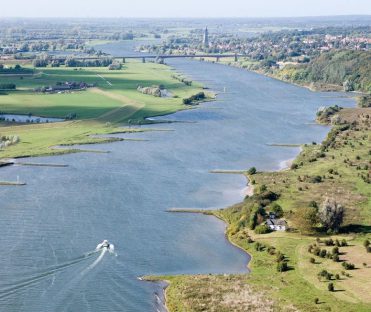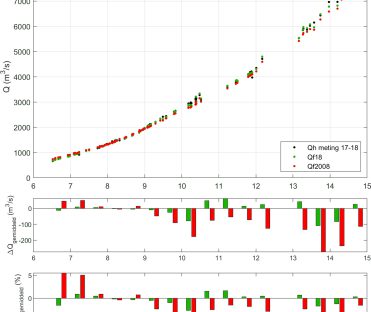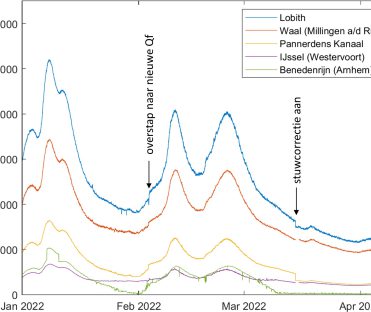New discharge data Rhine branches – based on new Qf relations set up by Svašek-Boorsma – implemented in national operational water database (Landelijk Meetnet Water)
Discharges of all five of the major Dutch Rhine branches (Bovenrijn, Waal, Pannerdensch Kanaal, IJssel and occasionally Nederrijn) are not continuously measured, but are instead derived from water levels via so called Qf relations. In principle Qf relations are Qh relations: there is a discharge (Q) for each measured water level (h). Reality is – as always – more complex due to hysteresis, weirs and barriers and trends over time such as bed level changes and construction of river works. All such aspects are incorporated in the predictive relations, hence the term Qf.
Relations as used up to the start of 2022 in the national operational water database (Landerlijk Meetnet Water, LMW) – and consequently all Rhine discharges as published by Rijkswaterstaat – were derived in 2009 and based on outdated information and insights. Svašek Hydraulics has been tasked by Boorsma to derive new Qf relations for Rijkswaterstaat for all five of the Rhine branches, now based on discharge and water level data from 1993 onward and numerous numerical simulations.
The new relations recently came on-line in the operational systems of Rijkswaterstaat. All users of these systems now automatically receive the improved discharge information. In practice it means that for given water levels, discharges will have changed. For example at Lobith: discharges at low water will be even lower, where at high water they can be considerably higher (up to 300 m3/s), see the validation (Figure 2) the period 2017-2018.
Transition to the new relations in LMW was not entirely smooth, as can be observed in data series that are freely available on for example Waterinfo.rws.nl (see Figure 3). The switch to the new system was made in early February, which can be seen as a clear discontinuity in the graphs. Not in the Nederrijn series though, which is usually directly based on measurements (ADM). In mid-March another discontinuity is visibly in the Bovenrijn and Pannerdensch Kanaal series. Enquiry at Rijkswaterstaat has revealed that the weir correction (part of the Qf relations) was only switched on at that time. The correction accounts for the fact that weirs on the Nederrijn (when raised) lead to lower discharges for given water levels on the Bovenrijn and Pannerdens Kanaal. Activating the correction thus leads to lower reported discharges on those branches. Even though weirs influence discharges on the Waal and the IJssel, there is no effect on the Qh relation, which means there is no ‘step’ in the corresponding time series (although there are some missing values).
All in all: exiting news! We at Svašek are proud to have contributed to the discharge data of the Rhine branches as now used in the entire country.
More information?
Please contact Bas van Leeuwen.
Lorem ipsum dolor sit amet, consectetur adipisicing elit, sed do eiusmod tempor incididunt ut labore et dolore magna aliqua. Ut enim ad minim veniam, quis nostrud
Bas van Leeuwen
Deputy director

MORE INFORMATION ABOUT SVAŠEK OR OUR EXPERTISES?
Please contact us or make an appointment.
CONTACT US


